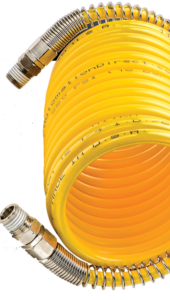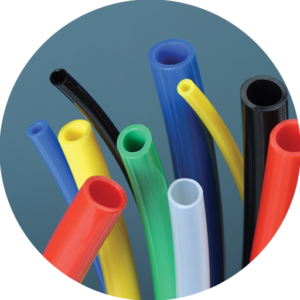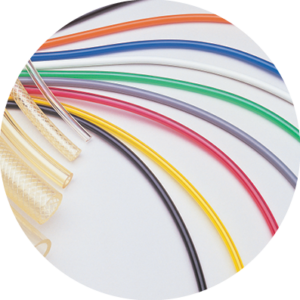
THE basic function of pneumatic tubing and hose is to convey pressurized air to actuators, valves, tools and other devices. But there are countless types and sizes of tubing and hose on the market, so engineers should consider a number of important factors to select the right one for a given task.
Start with construction. Tubing for air applications may be extruded of a single material or reinforced internally, typically with textile fibers, for higher strength. Pneumatic hose generally consists of an inner tube, one or more layers of reinforcing braided or spiral-wound fiber, and an outer protective cover. In broad terms, hose is more rugged than tubing but costs more.
The air supply and application set a baseline for the necessary product performance. Flow requirements help determine hose or tubing size. Tubing is generally specified by OD and wall thickness, while hose is specified by ID. Regardless, choosing too small an inner diameter “chokes” flow and results in pressure losses, inefficiency and excessive fluid velocity that can shorten service life. Too large a diameter, on the other hand, results in higher than necessary weight, size and cost.

Also ensure that products operate below the stated maximum working pressure. Manufacturers generally rate tubing by measuring the burst pressure at 75° F, and then divide it by an appropriate safety factor (typically 3:1 or 4:1) to determine the maximum working pressure. Keep in mind that published burst-pressure ratings are only for manufacturing test purposes, and in no way indicate that a product can safely handle pressure spikes or otherwise operate above maximum working pressure. Also note that some products handle vacuum to approximately 28 in.-Hg without collapse.

Thermoplastic tubing is made from several common materials. But manufacturers offer countless variations of polymer formulations to suit specific needs. Typical tubing materials used in pneumatic applications include: Polyurethane tubing is strong, flexible, kink and abrasion resistant, and it withstands contact with fuels and oils. It’s commonly used in pneumatic actuation and logic systems, robotics and vacuum equipment, and in a variety of semiconductor manufacturing, medical and laboratory applications.
Nylon tubing is tough, light and dimensionally stable. It can be formulated for higher-pressure pneumatics, flexibility for routing in tight spaces, high flexural-fatigue resistance and low water absorption.
Polyethylene tubing is often used in low-pressure pneumatics and pneumatic controls. It has wide resistance to chemicals and solvents, good flexibility and relatively low cost. HDPE tubing comes in semi-rigid versions that resist cuts and physical damage and has a higher burst pressure than polyethylene tubing.
Polyvinyl chloride (PVC) tubing is light and generally more flexible than nylon and polyethylene, offers good chemical resistance and can be repeatedly sterilized. It is suitable for low-pressure medical applications and can be formulated to meet FDA specifications for contact with food and drugs. PVC tubing is typically clear, and thus well-suited where visible indication of flow is necessary.
Polypropylene tubing can be formulated for food-contact applications, resists chemical attack and withstands UV radiation in outdoor applications.
Engineers should weigh the features, benefits and drawbacks of each material. One important factor is compatibility of fluids conveyed through the conduit. For instance in the case of air systems, oil from air lubricators, as well as fumes or other substances ingested by the compressor, could affect the inner tube. Likewise, remember exterior environmental exposure. Hose and tubing assemblies can be attacked by chemicals, ozone, UV radiation, salt water, air pollutants and other substances that lead to degradation and premature failure.
External mechanical influences can also hasten hose and tubing failure. Loads to keep in mind include excessive flexing, twisting, kinking, tensile and side loading, and vibration. Also protect against abrasive wear, snagging or bending beyond the minimum bend radius, all of which can lead to premature failure. Replace and discard any hose or tube that is cut, worn or otherwise damaged.
Two common physical characteristics to consider when selecting tubing are flexibility and kink resistance. These are often subjective, and it’s best to compare samples rather than rely on manufacturer’s literature. Another physical attribute is color. Tubing comes in a wide range of colors as well as clear, depending on the compound.
And don’t overlook the effect of temperature and heat on tubing materials—both inside and outside the assembly. Always operate within minimum and maximum temperature limits. In particular, be aware that elevated temperatures will impact working pressure, especially as tubing materials reach their upper temperature limit. For example, one version of nylon tubing with a 0.25-in. ID has a rated burst pressure of 1,250 psi at 75° F, but only 600 psi at 200° F.
Many fittings are available to build pneumatic tubing and hose assemblies for connection to mating components. These include barbed, push-to-connect, swaged, crimped and reusable versions; and they come in plastic, brass, steel, stainless steel and other materials. First and foremost, designers should ensure the fitting and tubing or hose are compatible with each other, as not every fitting design is suitable for every type of tubing or hose. Other important considerations for fittings include pressure-holding capacity, ease of installation, size and weight, corrosion resistance and, of course, cost.
Tubing is extruded in straight lengths and stored on reels, but it can also be molded into spring-like coils. This lets the tubing extend considerably as needed, then retract to a compact configuration for out-of-the-way storage. “Tails,” short, straight lengths of tubing that extend from each end of the coiled section, facilitate coupling attachment. Coil diameter, tubing diameter, wall thickness and the type of material affect retractability. Smaller and tighter coils generate more retraction force than do larger coils; polyurethane and nylon generally offer better material-memory characteristics. These tend to let the product collapse more easily.
In addition to standard products there are many variations. This can include products made for special attributes like high strength, abrasion resistance or compatibility with a specific chemical; characteristics like flame resistance, weld-spatter resistance, and electrical conductivity or nonconductivity; coextruded products that combine the properties of two materials in a single tube; and multiple tubes bonded together in a single assembly or tubes formed into elbows and bends.
Finally, hose and tubing sometimes must meet regulations or standards from agencies like FDA, DoT, UL and ISO. When questions arise regarding product compliance, experts always recommend seeking advice from application engineers from reputable manufacturers.

I have a small air compressor that my dad gave me, and it came with a coiled, yellow hose, like the one in the picture. I only use to paint with my airbrush, so the hose it much longer than I need. Would it be possible to cut it down to the right size? What sort of fitting would I need to buy to fix it up afterward?